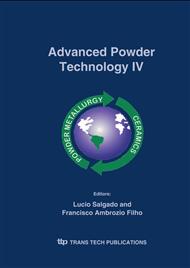p.697
p.704
p.710
p.717
p.722
p.728
p.734
p.740
p.747
Preparation and Characterization of NiAl2O4 Powder by the Pechini and Combustion Methods
Abstract:
Conventional methods to obtain ceramic powders are inadequate for many technological applications because these powders react but slightly to sinterization, displaying weak reproducibility, nonhomogeneity and imprecise stoichiometric control of cations. Better results can be obtained by chemical synthesis because the powder retains its homogeneity on the atomic scale and may be calcined at low temperatures, yielding fine particulate oxides whose chemistry can be precisely controlled. Therefore, the objective of this work was to obtain the NiAl2O4 phase by the Pechini and combustion reaction methods, and comparatively analyze how these two synthesization methods affect the characteristics of the resulting powder, which was characterized by DRX, MEV and BET. The results revealed that both methods yield nanometric and crystalline NiAl2O4 powder having homogenous particle sizes and shapes. The powder obtained by the Pechini method exhibited agglomerate sizes 60% smaller than those obtained by combustion reaction.
Info:
Periodical:
Pages:
722-727
Citation:
Online since:
November 2005
Keywords:
Price:
Сopyright:
© 2005 Trans Tech Publications Ltd. All Rights Reserved
Share:
Citation:


